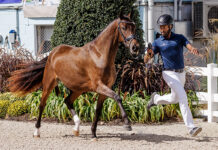Q: My horse has been ridden western his entire life but I’d like to try English riding. Is it hard to retrain a western horse for English? How do I get started?
Start by gathering up some traditional English tack. Because English horses respond to direct rein aids, put together a snaffle bridle with a mouthpiece that’s appropriate for your horse. Needless to say, you’ll also need an English saddle. And for safety reasons, always wear an ASTM-approved helmet, particularly if you’re planning on some jumping lessons.
Next, work on establishing a true working trot with your horse. This can be troublesome for a horse going from western to English. Rather than merely urging your horse to trot faster than his typical jog, you have to encourage him to stretch out his frame and lengthen his stride. His first inclination will be to break into a lope. Gently bring him back to a trot. Use lots of large circles at the working trot to help him stay balanced.
You’ll also need to work on your position in the saddle. Western riders have a tendency to sit too far back in an English saddle, with stirrups that are too long and hands that are carried below the withers. Plus, you’ll have to master the posting trot and the two-point, both hallmarks of English horsemanship. For these reasons, seek out a reputable English instructor in your area. While you can do a lot of work at home in your own arena, a professional who can provide support and constructive criticism will make the transition from western to English a more rewarding experience for both you and your horse.
–Cindy Hale
Ask your training questions on the HorseChannel.com Forums >>
See more Expert Q&As >>
Submit your Ask the Expert question >>







i was given a 5 year old appaloosa gelding, western trained and winning in western pleasure . i had him around 5 weeks, taught him to jump, then won the South Australian Pony Club State One Day Event 2009. the trainability and attitude of the ‘western’ breeds makes it this easy – western to english? don’t think about it, just DO it!
My riding teacher has a quarter horse called Annie. When she came in she had been trained wetern pleasure for the first 7 years of her life. Now she competes in show jumping and soars over 4’9″ fences like there is nothing in front of her. She loves to jump but can still pick up a nice western jog and lope when you ask for it. Switching disciplines can be great for horses. My mare can do english and western and I love being able to chose between the two.
Excellent!
this is wonderful! I am getting a stallion that is trained in western, and i only ride in english i’ve been so worried about what to do, this article is definitely helpful!
great article
I’ve ridden both English and Western style horses, and while the english tend to respond better to a change of pace, the westerns make for an easier pleasure ride. …in MY opinion
This was a very helpful article! My horse has, as far as i know, always been ridden western and I recently decided that I wanted to try english riding. My horse doesn’t seem to know the difference! But I’ve definitely got a lot to work on. Thanks for this great article! I love Horse Channel!
I seen I have a long ways to go.
Thanks
My cousins horse has rode western all her life and the owner of the stables wants an English horse. She is planning on having me come down weekly to work with the horse and so far, the most difficult thing is turning, trotting and keeping her on the rail.
Thankyou so much this helped me ALOT